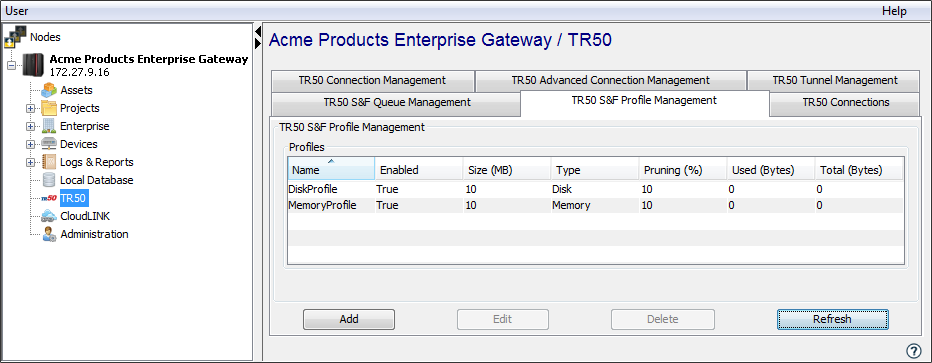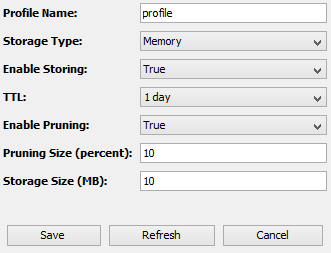A TR50 S&F profile is a global (to the gateway) definition of TR50 S&F settings. Multiple TR50 S&F profiles can be defined on a gateway. Once a S&F profile is defined, it can be selected in the S&F profile parameter for any S&F capable trigger action.
Each S&F profile determines where and how the actions will be stored, if they can not be sent to the M2M Service. The actual instance that contains the actions when storing is a TR50 S&F queue. For more information, see TR50 S&F Queue Management tab.
TR50 S&F Profile Management tab
The TR50 S&F Profile Management tab displays
the currently defined TR50 S&F profiles. This tab is
used to add, edit and manage TR50 S&F profiles.
The definition of Total Byteswould be the Number of Queues times the Profile Storage size (each connection has 1 queue). The user should read it as "System can use up to X (total bytes) for this profile".
For example: In face of 2 TR50 connections, then data shown would be 20MB, resulting from
2 times 10MB, equals to 20MB.
Used Bytes would be defined by the stored SAF message size in byte across different connections for a single profile.
TR50 add S&F profile
To define a TR50 S&F profile, select the Add button to open the TR50 Add S&F Profile window.

The TR50 S&F Profile table lists all the profiles defined on the gateway. The profiles listed in the table are global to the gateway, and not specific or limited to any one TR50 connection.
| Parameter | Description |
|---|---|
| Profile Name | A name to identify the S&F profile. |
| Storage Type | The type of storage for the S&F
queue that uses this S&F profile.
Options are Memory or Disk. Once a S&F profile is defined with a Storage Type of memory or disk, the Storage Type parameter can not be changed when the S&F profile is edited. The change to the Storage Type can be completed if the Profile Name is also changed. This results in a new S&F profile. For more information, see TR50 Storage Type considerations. |
| Enabled Storing | An option to enable or disable storing. |
| TTL | TTL is Time To Live. The maximum length
of time the data will be stored in a
S&F queue before it is discarded. The options are 1 hour, 12 hours, 1 day, 3 days, 1 week or Custom. |
| TTL Custom (sec) | Displayed when the TTLparameter is set to Custom. Specifies a custom TTL value in seconds. |
| Enabled Pruning | An option to enable or disable pruning
(discarding) of the data stored in a
S&F queue. Pruning of a S&F queue takes place when the S&F queue becomes full. |
| Pruning Size (%) | Displayed when the Enabled Pruning parameter is set to True. The percentage of data in the S&F queue that will be pruned. |
| Storage Size (MB) | The maximum size of the S&F queue, in MBytes. |
TR50 edit S&F profile
To edit a TR50 S&F profile, select the TR50
S&F profile:
- Then select the Edit button to open the TR50 S&F Edit Profile window.
- Changes to parameter values will take effect immediately, as indicated.

| Parameter | Description |
|---|---|
| Profile Name | Editing the Profile Name will result in a new TR50 S&F profile being created (duplicated) with the new name. |
| Storage Type | The type of storage for the S&F
queue that uses this S&F profile.
Options are Memory or Disk. The Storage Type parameter can not be changed when the S&F profile is edited. The change to the Storage Type can be completed if the Profile Name is also changed. This results in a new S&F profile. For more information, see TR50 Storage Type considerations. |
| Enabled Storing | Will take effect immediately for new messages coming in through the TR50 S&F Profile. |
| TTL | Will take effect immediately for both new and existing messages. |
| Enabled Pruning | Takes effect immediately. Pruning will happen immediately if necessary. |
| Pruning Size (%) | Takes effect immediately. Pruning will happen immediately if necessary. |
| Storage Size (MB) | Takes effect immediately. If the size is decreased, pruning will happen immediately if necessary in order to resize. |
TR50 delete S&F profile
To delete a TR50 S&F profile, select the TR50 S&F profile and then select the Delete button. Deleting a profile is an unrecoverable action.
Deleting a profile will cause loss of stored data
in any S&F queue that is associated with the
profile.

TR50 Storage Type considerations
The options for the TR50 S&F Storage Type
parameter are: Memory or Disk.
The storage type considerations include:
For Memory:
- Uses Random Access Memory
- Faster operations than using the Disk
option
- The data in a queue will not be retained if deviceWISE (or the operating system) is restarted.
For Disk:
- Uses persistent (or non-volatile)
storage
- Slower operations than using the Memory
option
- The data in a queue will be retained if deviceWISE (or the operating system) is restarted. The TR50 S&F queues are created in the Staging Browser area directory: /staging/system/qds.
Changing the Storage Type of an existing TR50 S&F Profile:
- The Storage Type parameter can not be changed
when the S&F profile is edited, unless the
Profile Name is also changed. This results in a new
S&F profile.
This restriction is related to the handling of any S&F queues and their contents while this type of change is attempted.
To change the Storage Type of a TR50 S&F Profile:- Edit the profile with a different Storage Type parameter and a different Profile Name. Save the new profile.
- Delete the original profile. This should take place when there is no data in S&F Queue that is associated with the S&F Profile.
- Edit the new profile and change the Profile Name to the one used by the original profile.
TR50 Storage Type limitations
The Storage Type = Disk option is not available on the following platforms:
- Asset Gateway for Option CloudGate V1
- Asset Gateway for USRobotics